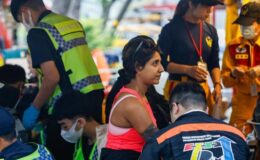Citizens of China spread wings as 2 MONTH mandatory lockdown is lifted.
- By : James Bryson
- Category : Health, World Events

The vast majority of the 25 million inhabitants of the eastern Chinese metropolis of Shanghai returned to their streets today after the authorities ended more than two months of a strict confinement imposed to stop their worst outbreak of covid.
The end of the lockdown came at midnight on Wednesday, and some Shanghainese celebrated their regained freedom in the most traditional way possible: by setting off fireworks.
Others, bottle of champagne in hand, threw themselves into a toast with friends and family whom they had not seen since the end of March, according to videos on social networks.
After dawn, the scenes of euphoria gave way to those of the long-awaited normality, with road traffic that began to remind us of the Shanghai of always, although there were still many shops closed, and those that opened are limited to 75% of their capacity. capacity.
And since restaurants still cannot accommodate diners, many chose to order take-out and organize impromptu picnics in green areas downtown.
At the moment, gyms, museums or cinemas are also not authorized to open.
Pedestrians and office workers once again intermingled in the streets with the legions of delivery men who kept the supply lines alive these weeks, among whom many were forced to live in tents because their urbanizations did not allow them to come and go. to work.
The last part of infections added 15 new cases, far from the peak of almost 28,000 in mid-April; Since the start of the outbreak, at the end of February, 58,000 confirmed cases have been added to the city – that is, symptomatic, because asymptomatic ones do not add to the official balances in China – and 588 deaths.
GRADUAL NORMALITY AND “WITH CONDITIONS”
Despite the euphoria, Shanghai has not fully recovered “normality” overnight, since, according to official media reports last night, around 90% of the population will be able to take to the streets “under conditions”, while that the rest will still have to wait, especially the nearly 200,000 who live in the few areas where new infections are still being registered.
In addition, carrying out routine activities such as taking public transport or going to buy at a supermarket will require a negative covid test carried out in the last 72 hours, a requirement that will apply even when entering or leaving urbanizations.
To do this, under orders from Beijing, the city has erected up to 15,000 sample collection kiosks, with a municipal-level processing capacity of about 8.5 million tubes every day and more than 50,000 workers authorized to carry out the tests.
Since this morning there were long but brisk queues in front of these stalls.
The tests will be free until June 30, and after that they will cost 16 yuan (2.4 dollars, 2.25 euros), although the authorities have not specified if this requirement is here to stay.
What has surely been a relief for many residents is the withdrawal, announced by the Government, of the decision-making power of the neighborhood committees -the bodies that govern the urbanizations- to be able to leave or not the residential complexes.
In recent weeks, despite the fact that most citizens were already in areas where, on paper, they could take to the streets, many of these committees kept the accesses sealed under the silent connivance of the municipal government.
The final days of May, considered “transition”, have also left other positive news such as the dismantling of many of the fences installed in the streets -in some cases, real barricades- or the closure of some of the internment centers in that the infected were admitted.
Today, the newspaper The Paper confirmed the closure of the largest of these complexes, the one established in the National Convention and Exhibition Center, opened on April 9 and through which almost 175,000 people passed.
For many, the prospect of becoming infected was doubly terrifying because in these centers it was common to be with thousands of other infected in cubicles with little privacy.
A HIDDEN SCAR
On this day of life returning to the streets, not only were the smiles of liberation hidden behind the masks, but also the deep scar that the endless weeks of uncertainty left on the mental health of the inhabitants.
Although, as usual, the official press took pains to find positive angles and try to calm things down with articles and videos with inspiring, supportive or optimistic themes, many will have to fight to overcome a truly traumatic experience.
In recent weeks, and despite the tireless work of the censors, social networks have transmitted stories – many of them unverified – of protests against the measures and the difficulty of obtaining food, of parents and children separated during confinement or of deaths due to lack of medical assistance.
The best example of widespread discontent occurred on April 23, when the networks burned with a video called ‘Voces de Abril’, which collected various recordings of the suffering caused by confinement, in a real fight against censorship, which was erasing.
In some cases, the local authorities tried to delegitimize the protests – staged, for example, with caceroladas – by the neighbors, assuring that they were “incited by foreign forces”.
The scar is also being felt, according to official data, in economic indicators, since production in factories was totally paralyzed for weeks, starting again at the end of April for some companies -for example, Tesla-, which had to host their workers to isolate them from the outside.
As of today, although some factories will continue to operate under this “closed loop” system, special permits will no longer be necessary to resume production in the city, which has already announced a plan to “revitalize” the economy.



No Comments